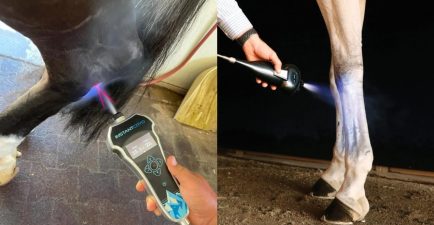Almost every equestrian has heard the saying, “it’s not if you fall, but when…and how hard.” Horseback riding is a wonderful, exciting sport—but it’s also a dangerous one. Piloting a half-ton animal with a mind of its own from 5-plus feet off the ground comes with inherent risks. Did you know that per hour of exposure, horseback riding has a higher injury rate than so-called extreme activities such as downhill ski racing, hang gliding and riding motorcycles? Of the injuries reported by equestrians, head injuries are the most common type, as well as the leading cause of death in horse-related accidents.
Read on for more interesting—and sobering—statistics about the hazards of horseback riding—and how wearing a riding helmet can save your life. After all, another popular adage among equestrians is “you can fix a broken bone, but you can’t fix a broken brain.”
- Thirteen percent of equestrians will end up in the hospital. Equestrians who ride at least six times per year reported a 13% lifetime rate of being hospitalized due to a riding injury. The risk of injury isn’t necessarily tied to the rider’s experience; increased risk comes with increased time in the saddle.
- One percent of equestrians will end up in the emergency room. In the United States, some 7 million people engage in horse-based activities every year. Of these, 70,000 will go to the emergency room for a horse-related injury.
- Head injuries account for 18 percent of emergency room injuries among equestrians. Every year, nearly 13,000 riders will go to the emergency room because of a head injury sustained during a horse-based activity. These injuries include lacerations, concussions and traumatic brain injuries.
- Head injuries are associated with nearly 60 percent of all equestrian deaths.
- According to the American Medical Equestrian Association, ASTM/SEI-certified helmets reduce horse-related head injuries by 30 percent and severe head injuries by 50 percent.
- Helmets should be replaced after any hard impact—even if that impact is simply from being dropped on hard ground. Even if a helmet has never been involved in an accident, it’s a good idea to replace helmets every five years, or even more frequently if the helmet has been exposed to extreme temperatures. This ensures that the helmet is up to industry standards and that the helmet’s effectiveness has not been compromised by unseen deterioration.
- There is little statistical difference in head injuries among English riders versus Western riders. The risk for head injuries appears similar across the disciplines. These days, helmets come in many styles and designs to suit a wide variety of rider aesthetics.
- Good news for budget-conscious equestrians! Expensive helmets are not necessarily safer. As long as the helmet is fitted properly, all ASTM/SEI-certified helmets provide the same level of protection. A more expensive helmet might feature different materials and design modifications, but it does not provide increased protection. Non-ASTM/SEI-certified helmets offer no protection whatsoever and are strictly for cosmetic purposes.
- Bicycle helmets are not suitable for horseback riding. Riding accidents are very different than bicycling accidents; they have different speeds, heights and trajectories, and impact different parts of the head. A bicycle helmet will not provide equestrians with adequate protection.
- Riding with helmet-wearing friends is good for your head! A German study suggests that when a rider’s peers wear helmets, he or she is more likely to as well.
Original article: 10 Important Facts about Horseback Riding Helmets – Equus Magazine

























